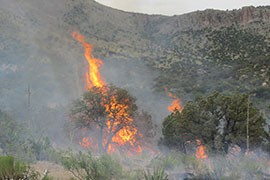- Slug: BC-CNS-Wildfire Prep,590
- Photos available (thumbnails, captions below)
By JAMIE COCHRAN
Cronkite News
WASHINGTON – Federal officials said Tuesday they will be “ready when fire strikes,” but raised concerns over funding for the upcoming wildfire season and the growing threat of catastrophic wildfires in the drought-stricken West.
In a conference call, the secretaries of Interior and Agriculture and the chief of the U.S. Forest Service said the season is off to a relatively slow start, but that they eventually expect it to be an above-average year for fires in many states.
Parts of the country that are at risk include “southern Arizona, and, of course, California just like it was last year, and it’s going to continue,” said Tom Tidwell, chief of the Forest Service.
That slow start has been the case in Arizona – where officials also cautioned they do not expect the situation to remain that way.
An unusually rainy period had delayed the start of the season in Arizona which is “below normal” so far, said Carrie Dennett, state fire prevention officer for the Arizona State Forestry Division.
“In June, we would expect to see larger fires, more frequent fires, but because of the rain coming in periodically, it’s kind of tempered or delayed our fire season,” Dennett said. “So we’re not seeing fires grow as big.”
There are several fires currently burning in Arizona, the largest of which is the Guadalupe Fire east of Douglas. That fire, which was started June 2 by a lightning strike, had burned about 5,900 acres by June 9, when it was 50 percent contained, according to fire officials.
Should the fire season heat up, federal officials said they are better prepared now than they have been in the past.
Agriculture Secretary Tom Vilsack said the government enters this wildfire season with 21 fixed-wing large air tankers, compared to the 11 that available a few years ago, and 100 helicopters ready to be put into action.
The Forest Service will employ more than 10,000 firefighters during this fire season.
Vilsack credited Congress for the improvements in firefighting equipment, but he and the others on Tuesday’s conference call said funding remains a long-term concern.
“Last year we exceeded our appropriated fire suppression funds by $240 million,” Tidwell said. “And, once again, we are lined up to probably have to deal with that again.”
Besides more funding, the officials called for more flexibility in how wildfire funds are budgeted, to include a focus on prevention.
That call was echoed Tuesday by Rep. Ann Kirkpatrick, D-Flagstaff.
“Prevention is the best investment because it reduces not only the cost of fighting catastrophic wildfires, but the cost of rehabilitating regions after they are devastated by these fires,” she said in statement released by her office. “Most important, prevention saves lives.”
Vilsack said federal officials will “continue to work collaboratively with local and state governments and other organizations to build the awareness of the need for individual homeowners and communities to be fire-ready.”
Interior Secretary Sally Jewell said homeowners and private citizens also need to be involved in preventing fires.
“We all have a role to play here,” Jewell said. “We need help from homeowners and local communities to better protect themselves from wildfires throughout before the fires begin.”
She said that neighbors helping each other clear brush and trees from around their homes will “lessen the risk to communities and firefighters when they respond.”
Dennett said that, despite a slow start to the wildfire season, it is not time to relax.
“As always, everybody needs to be careful with fire when they are out in the woods,” she said.
^__=
Web Links:
_ SWCC: http://gacc.nifc.gov/swcc/predictive/intelligence/intelligence.htm
_ Arizona State Forestry Division: https://azsf.az.gov/
^__=
A firefighter conducts a prescribed burn at the Big Windy Complex fire near Galice, Oregon, in this file photo from August 2013. (Photo by Lance Cheung/U.S. Department of Agriculture)
A view from the fireline June 5 of the Guadalupe Fire, which was started by lightning and had burned 5,900 acres in the Coronado National Forest in a week. (Photo courtesy U.S. Forest Service)

